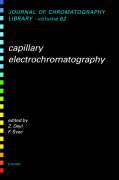Read more
This book discusses the evolution and uses for capillary electrochromatography as a new dimension to current separation science. With the emergence of this technique the selection of available separation mechanisms increases dramatically. The book also discusses the new horizons in the separation of non-polar compounds which have been opened as a result of CEC. Over ten chapters authors cover a wide variety of topics and provide the reader with necessary theoretical background, description of the instrumentation, modes of operation and methods of detection and an overview of the broad variety of applications of capillary electrochromatography. To view the full contents as a pdf, please click /inca/publications/misc/621924_contents.pdfhere.
List of contents
Selected Contents. Preface. List of Contributors. Chapter 1 - Migration of charged sample components and electroosmotic flow in packed capillary columns. Chapter 2 - Instrumentation for capillary electrochromatography. Chapter 3 - Modes of CEC Separation. Chapter 4 - Packed bed columns. Chapter 5 - Capillary electrochromatography on monolithic silica columns. Chapter 6 - Capillary column technology: continuous polymer monoliths. Chapter 7 - Open tubular approaches to capillary electrochromatography. Chapter 8 - Hyphenation of capillary electrochromatography and mass spectrometry: instrumental aspects, separation systems and applications. Chapter 9 - Pressure supported CEC: a high-efficiency technique for enantiomer separation. Chapter 10 - Applications. Index of compounds separated.
Summary
Discusses the evolution and uses for capillary electrochromatography as a fresh dimension to separation science. This book also discusses the new horizons in the separation of non-polar compounds which have been opened as a result of CEC. It provides an overview of the variety of applications of capillary electrochromatography.

